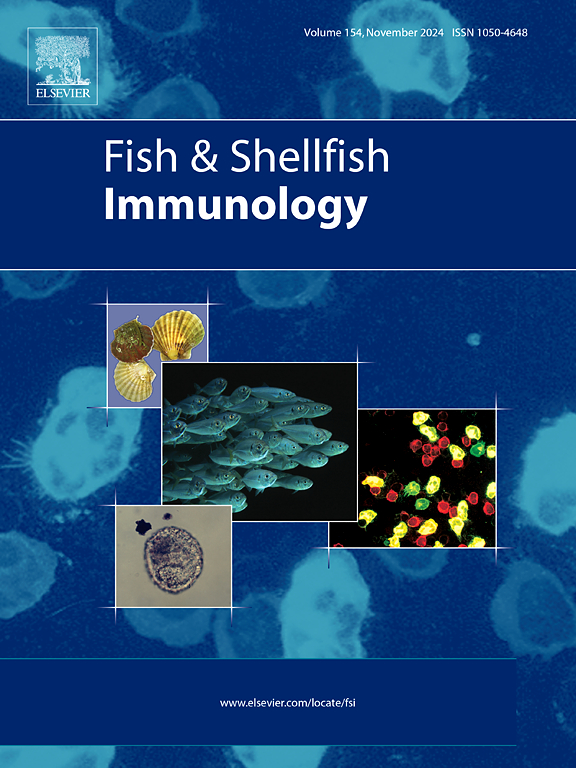Isolation and identification of a strain of Pseudomonas putida and its effect on histopathology, apoptosis, and gene expression in turbot (Scophthalmus maximus)
IF 3.9
2区 农林科学
Q1 FISHERIES
引用次数: 0
Abstract
Turbot (Scophthalmus maximus) is one of the most widely species that boasts high economic value in the aquaculture industry. In spite of the exponential growth of aquaculture, infectious bacterial diseases have caused great economic losses in turbot industry. This study isolated and identified a strain of Pseudomonas putida, denoted as DY16, and it is a conditionally pathogenic bacterium, therefore we conducted the following research on it. The morphological, physicochemical, and genomic characteristics of bacteria and their pathogenic mechanisms were analyzed by morphological and biochemical characterization and genome sequencing. P. putida effects on the histology and immune-related gene response of turbot were then assessed. Histopathology and TUNEL assay showed that P. putida caused severe damage and induced apoptosis in the gills, intestines, spleen, and liver of turbot, respectively. In addition, this study indicated that the immune-related genes, such as ap4m1, prkca, traf4, itgb4, glb1, and mylk in various turbot tissues after infection with P. putida. Hence, it was hypothesized that these genes could be involved in host immune response and gene regulation in P. putida. Conclusively, P. putida infection caused pathological changes in the gills, intestines, spleen, and liver tissues of turbot and induced significant apoptotic and immune responses. These findings provide useful information and a theoretical basis for further understanding the immune defense mechanisms of P. putida and turbot offering guidance for the prevention and treatment of bacterial diseases in fish.
一株恶臭假单胞菌的分离鉴定及其对大菱鲆组织病理学、细胞凋亡和基因表达的影响。
大菱鲆(schophthalmus maximus)是水产养殖业中分布最广、经济价值最高的品种之一。尽管养殖业呈指数级增长,但传染性细菌性疾病给大比目鱼产业造成了巨大的经济损失。本研究分离鉴定出一株恶臭假单胞菌,记为DY16,它是一种条件致病菌,因此我们对其进行了以下研究。通过形态、生化鉴定和基因组测序,分析了病原菌的形态、理化和基因组特征及其致病机制。然后评估恶臭杆菌对大菱鲆的组织学和免疫相关基因反应的影响。组织病理学和TUNEL实验显示,恶臭杆菌分别对大比目鱼的鳃、肠、脾和肝脏造成严重损伤并诱导细胞凋亡。此外,本研究表明,感染p.p putida后,免疫相关基因ap4m1、prkca、traf4、itgb4、glb1和乳汁在各种大鲆组织中均有表达。因此,我们推测这些基因可能参与了putida的宿主免疫反应和基因调控。综上所述,putida感染可引起大比目鱼的鳃、肠、脾和肝组织的病理改变,并诱导显著的凋亡和免疫反应。这些发现为进一步了解恶臭杆菌和大菱鲆的免疫防御机制提供了有益的信息和理论基础,为鱼类细菌性疾病的预防和治疗提供了指导。
本文章由计算机程序翻译,如有差异,请以英文原文为准。
求助全文
约1分钟内获得全文
求助全文
来源期刊

Fish & shellfish immunology
农林科学-海洋与淡水生物学
CiteScore
7.50
自引率
19.10%
发文量
750
审稿时长
68 days
期刊介绍:
Fish and Shellfish Immunology rapidly publishes high-quality, peer-refereed contributions in the expanding fields of fish and shellfish immunology. It presents studies on the basic mechanisms of both the specific and non-specific defense systems, the cells, tissues, and humoral factors involved, their dependence on environmental and intrinsic factors, response to pathogens, response to vaccination, and applied studies on the development of specific vaccines for use in the aquaculture industry.
 求助内容:
求助内容: 应助结果提醒方式:
应助结果提醒方式:


